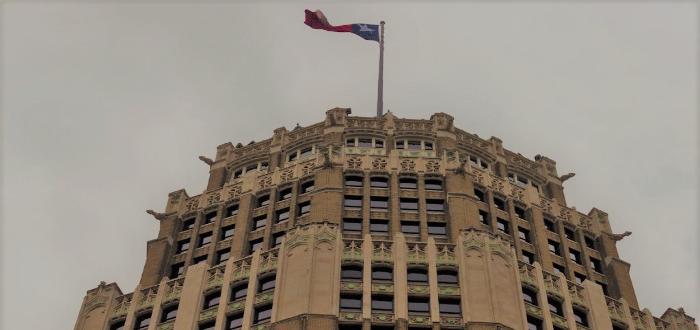The Fall of Uncertainty
September 13, 2023

Photo credit goes to Vagueonthehow
We should call this the Fall of Uncertainty. We are uncertain as to falling or rising inflation; uncertain as to higher interest rates, one of the largest factors in valuing real estate; uncertain as to true new values of real estate; uncertain as to whether we are now in a recession, or will be going into a recession or whether there will be no recession; uncertain as to when we will enter the Next Normal phase, or whether Uncertainty itself is the next New Normal. Aarrgghh.
Let’s whip around San Antonio and see how our bit of the Universe is doing right now. The Value numbers below are for the national market, not San Antonio, and come from Green Street Advisors, the top commercial real estate analysts.
Office: Values down 31%
The most uncertain part of our market is office buildings and especially downtown. Mayor Castro’s Decade of Downtown, while successful in stimulating tremendous growth in residential and office development in the center city, ended with a thud in 2020, its final tenth year with the Covid lockdowns.
Now, San Antonio and Austin are fast growing markets and our fair city is often considered one of the most resilient markets. However, Rackspace left a 1.3-million square foot hole when they left their former headquarter building, formerly known as Windsor Park Mall, in Windcrest.
USAA, located in downtown SA and one of the biggest job-maker entries into the city core with its acquisitions of One Riverwalk and Bank of America Plaza, moved all of their employees back to the main campus on IH-10. Code-Up left, too. Rented occupancy is now below 80% and physical occupancy is below 50%, as the hybrid work week of Tuesday – Wednesday – Thursday has taken hold from simply Work from Home. This trend is national, but we are in no way exempt.
The only bright spot is the Pearl District with the Oxbow office building, Jefferson Bank Building and Bank of America Building all doing well. Add in the Soto, 6-story 168,000 square foot office building on the former Cavender Cadillac location, just south on Broadway, and that sums up what is certainly working in El Centro.
Multifamily: Values down 20%
Construction is doing well, not slowing much. We are on track to deliver 6,000 new units this year, an additional 6,000 next year and 6,000 in 2025. It takes about 3 years from identifying a new site, to when the project is in lease-up, so we can see the new delivery pipeline out for several years to come. Occupancies have dropped from 93% down to 88% and rents have softened. The demand for housing long term is good, but right now, not so good.
Residential is still doing well downtown. Weston Urban is forging ahead with its 300 Main 354-unit Class AA 32-story high-rise residential structure, even while its Frost Bank Plaza is less than fully leased. Weston is also planning the Continental Block mixed-use development with over 300 units. Now consider the redevelopment of the Tower Life Building from office to residential. These are being added into the 10,000 or so apartment units built in the Decade of Downtown. I do not understand the dynamic of moving downtown when jobs seem to be leaving there, so I am uncertain of the strength of this trend. We should keep an eye on it, though.
Retail: Values down 9%
Retail is actually very strong city-wide. Housing supply spawns the need for more retail, but higher costs are severely limiting new construction. Higher costs include 1. construction materials 2. land costs. 3. extremely higher property taxes 4. higher insurance costs due to disasters and climate change concerns, 5. much higher costs to finish out the interior spaces for the tenant, etc. San Antonio already has high rents, and so local tenants are having trouble making them affordable.
Industrial: Values down 8%
This property sector is doing very well in San Antonio with about 8-million square feet under construction and occupancies above 95%. Big box industrial, that is, 50,000 square feet to 500,000 square feet is usually built spec, that is, without tenants in tow. They just get leased up because demand is high, but this takes very large capital allocations to pull off (read “lots and lots of patient money”).
Investment Sales
Investment sales transaction volume has been off considerably over the past year because of the drop in values I referenced above in the national marketplace. For example, the number of Apartment sales is off 50%. Sales only happen maybe every 3 years or up to 10 years per property and now the pace is much slower.
Sellers are reluctant to put their properties on the market when profitability is stressed by the high cost of debt, so discovering the real true value is difficult. Green Street Advisors, whom I referenced above, say that the national average value across all property sectors prices is down 15% from the peak in 2022. This is all primarily due to the increase in interest rates.
Consider that the Lender has about 60% to 75% of the purchase price invested in the property via the property loan, so the interest expense is a major non-operating expense. With rates likely to go higher at some point, this continues to put downward pressure on prices. Then, there is the uncertainty that the higher rates will push us into Recession, hurting the profitability of tenants and their ability to pay high rents.
Therefore, owners are reluctant to become sellers unless they are forced. The crisis comes when the owner must refinance and so they must get an appraisal, which may show their property value has declined. Then as a result, the lender won’t finance as much, maybe not even as much as the current loan amount. Coupled this with the higher interest expense so that the owner must come out of pocket with new money to put into his deal, but then he and his investors don’t have the new money to put into the deal and so the outcome is, well, “uncertain,” shall we say.
Approximately, $1.2-trillion of distressed debt nationally must be refinanced in the next 18 months. Wall Street firms, never missing a perceived opportunity, are raising billions of dollars for Opportunity Funds to pounce on problem properties.
But this too will pass. We live in a great area of the country with smart, hardworking folks who care deeply about our community. Our next patch of good road is just ahead of us.
Please send comments to raub@volamdolong.com

